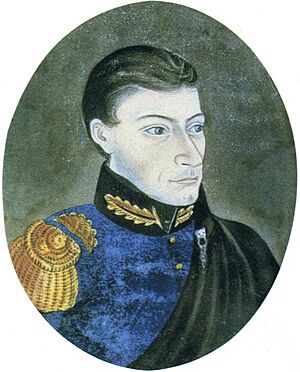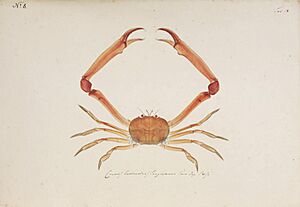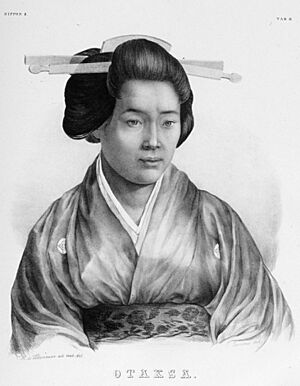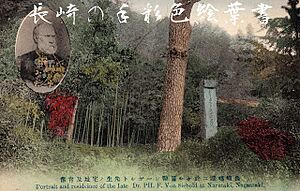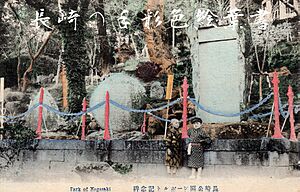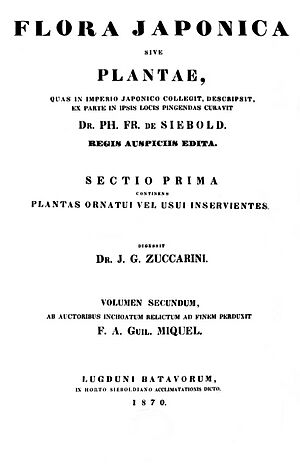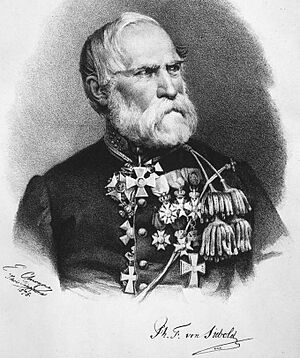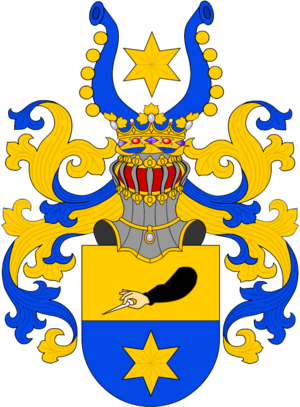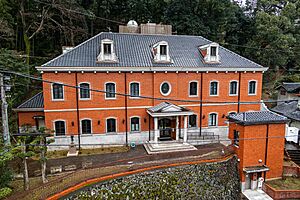Philipp Franz von Siebold facts for kids
Quick facts for kids
Philipp Franz von Siebold
|
|
|---|---|
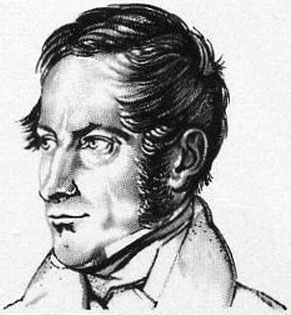 |
|
| Born | 17 February 1796 |
| Died | 18 October 1866 (aged 70) Munich, Kingdom of Bavaria
|
| Nationality | German |
| Occupation | Physician, botanist |
| Partner(s) | Kusumoto Taki, Helene von Gagern |
| Children | Kusumoto Ine, Alexander von Siebold, Heinrich von Siebold |
Philipp Franz Balthasar von Siebold (born February 17, 1796 – died October 18, 1866) was a German doctor, plant expert, and explorer. He became famous for studying the plants and animals of Japan. He also helped bring Western medicine to Japan. His daughter, Kusumoto Ine, became the first Japanese woman to be trained as a Western doctor.
Contents
Siebold's Early Life and Travels
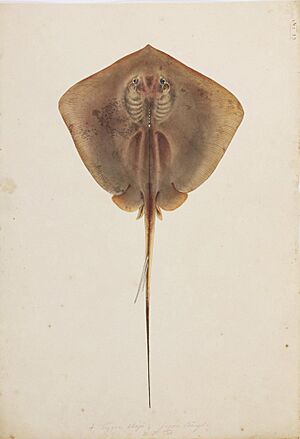
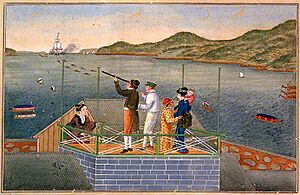

Becoming a Doctor and Explorer
Philipp Franz von Siebold was born in Würzburg, Germany. His family had many doctors and professors. He studied medicine at the University of Würzburg starting in 1815. One of his teachers, Ignaz Döllinger, taught him to see medicine as a natural science. Siebold was inspired by the books of Alexander von Humboldt, a famous explorer. He earned his medical degree in 1820.
In 1822, Siebold joined the Dutch military as a ship's surgeon. He sailed from Rotterdam to Batavia (now Jakarta) in what is now Indonesia. On this long trip, he learned the Dutch and Malay languages. He also started collecting sea animals.
Arriving in Japan
In 1823, Siebold was sent to Dejima. This was a small, artificial island and trading post in Nagasaki, Japan. At that time, Japan had very strict rules. Only a few Dutch people were allowed to live on Dejima. Siebold was chosen to be both the doctor and a scientist there. He arrived on August 11, 1823.
Earlier, other European doctors and plant experts like Engelbert Kaempfer and Carl Peter Thunberg had also visited Japan. They helped start the tradition of sending doctors with knowledge of plants to Japan.
Siebold's Work in Japan
Bringing Western Medicine to Japan
Japanese scientists were very interested in Western science. They invited Siebold to share his knowledge. In return, he learned a lot about Japan and its customs. After he successfully treated an important local officer, he was allowed to leave the trading post. This let him treat Japanese patients in the area around Dejima. Siebold is known for bringing vaccination and modern anatomy studies to Japan for the first time.
In 1824, Siebold opened a medical school in Nagasaki called the Narutaki-juku. About fifty students came to learn from him. These students also helped him with his studies of plants and nature. For many years, Dutch became the common language for scientific discussions in Japan.
People often paid Siebold with interesting objects and artifacts. These everyday items later became a huge collection of Japanese household goods, art, tools, and crafts.
His Japanese Family
While in Japan, Siebold had a family with Kusumoto Taki. Their daughter, Kusumoto Ine, was born in 1827. Siebold called Kusumoto Taki "Otakusa" and even named a type of Hydrangea flower after her. Kusumoto Ine grew up to be the first Japanese woman to become a trained doctor. She became a highly respected physician and even served the Japanese Empress in 1882.
Studying Japanese Nature
Siebold was most interested in studying Japan's plants and animals. He collected as much material as he could find. He started a small garden behind his home on Dejima. There, he gathered over 1,000 native plants. He even built a special greenhouse to help Japanese plants get used to the Dutch climate.
Japanese artists, like Kawahara Keiga, drew and painted these plants for him. They also drew pictures of daily life in Japan, which added to Siebold's collection of Japanese objects. He hired Japanese hunters to find rare animals and collect samples. Many Japanese helpers, including doctors and botanists, assisted him. His assistant, Heinrich Bürger, also continued Siebold's work in Japan.
Siebold introduced many well-known garden plants to Europe. These include the Hosta and the Hydrangea otaksa. He also secretly sent tea plant seeds to a botanical garden in Batavia. This single act helped start the tea industry in Java, which was a Dutch colony at the time. Before this, Japan strictly controlled the trade of tea plants. By 1833, Java already had half a million tea plants.
He also brought Japanese knotweed to Europe. This plant has since become a very invasive weed in Europe and North America. All these plants came from a single female plant that Siebold collected.
Siebold sent many plant and animal samples to Europe. These included the first Japanese giant salamander specimens ever sent to Europe.
The Siebold Incident
In 1826, Siebold traveled to Edo (now Tokyo) to visit the Japanese court. During this long trip, he collected many plants and animals. But he also got some secret maps of Japan and Korea from the court astronomer. This was strictly forbidden by the Japanese government.
When the Japanese accidentally found out Siebold had these maps, they accused him of being a spy. They believed he was working for Russia. Siebold was placed under house arrest. On October 22, 1829, he was expelled from Japan. He returned to Batavia with his huge collection of animals, plants, books, and maps. He arrived in the Netherlands in 1830.
Siebold's Return to Europe
When Siebold arrived in the Netherlands, he quickly moved his collections to Leiden. He left some living plant collections in Ghent, which helped that city become famous for its gardens.
Siebold settled in Leiden with most of his collection. His "Philipp Franz von Siebold collection" was the first large collection of Japanese plants in Europe. It had about 12,000 samples. The Dutch government bought this entire collection. Siebold was also given money each year by the Dutch King William II. He was made an "Advisor to the King for Japanese Affairs." In 1842, the King even made Siebold a nobleman.
The "Siebold collection" opened to the public in 1831. In 1837, he started a museum in his home. This small museum later became the National Museum of Ethnology in Leiden. Siebold's successor in Japan, Heinrich Bürger, sent him even more plant samples. These collections are now part of the Naturalis Biodiversity Center, a large natural history museum in the Netherlands.
In 1845, Siebold married Helene von Gagern. They had three sons and two daughters.
His Important Books
While in Leiden, Siebold wrote a major work called Nippon starting in 1832. This book was about Japan's culture and geography. It had many beautiful illustrations. He also wrote Flora Japonica with another botanist, Joseph Gerhard Zuccarini. This book, published between 1835 and 1870, made Siebold famous in Europe for his scientific work.
Many plants from Siebold's collections spread from the Hortus Botanicus Leiden (Leiden's botanical garden) to other gardens around the world. These include Hosta, Hortensia, Azalea, and the Japanese larch.
Later Years and Legacy
After returning to Europe, Siebold tried to use his knowledge of Japan. He even advised the Russian government on how to trade with Japan. He also spoke with American Naval Commodore Matthew C. Perry before Perry's famous trip to Japan in 1854.
In 1858, the Japanese government allowed Siebold to return. He went back to Japan in 1859 as an adviser. However, his advice was not always valued, and he eventually returned to Europe. He tried to get another job as a consul in Japan but was unsuccessful. Philipp Franz von Siebold died in Munich on October 18, 1866.
Plants and Animals Named After Siebold
Many plants and animals have been named in honor of Philipp Franz von Siebold because of his important studies.
Plants Named After Siebold
- Acer sieboldianum or Siebold's Maple: a type of maple tree from Japan.
- Calanthe sieboldii: an orchid from Japan, the Ryukyu Islands, and Taiwan.
- Clematis florida var. sieboldiana: a beautiful and popular type of Clematis flower.
- Corylus sieboldiana: the Asian beaked hazelnut tree.
- Hosta sieboldii: a very common garden plant with many different types.
- Magnolia sieboldii: a small magnolia tree.
- Malus sieboldii: the fragrant Toringo Crab-Apple tree.
- Primula sieboldii: the Japanese woodland primula flower.
- Prunus sieboldii: a type of flowering cherry tree.
- Sedum sieboldii: a succulent plant with rose-like leaves.
- Tsuga sieboldii: a Japanese hemlock tree.
- Viburnum sieboldii: a large shrub with white flowers and red berries.
Animals Named After Siebold
- Enhydris sieboldii: Siebold's smooth water snake.
- Nordotis gigantea: a type of abalone (a sea snail) known as Siebold's abalone, which is popular for sushi.
- Sieboldius: a group of large dragonflies.
Siebold Museums
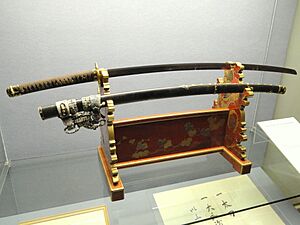
Several museums honor Philipp Franz von Siebold and his work:
- SieboldHuis in Leiden, Netherlands: This museum shows highlights from Siebold's collections in his former home.
- Naturalis Biodiversity Center in Leiden, Netherlands: This museum holds the huge collection of animals and plants Siebold brought back from Japan. It includes thousands of mammals, birds, fish, reptiles, invertebrates, and plant samples.
- National Museum of Ethnology in Leiden, Netherlands: This museum houses the large collection of Japanese everyday objects and artifacts that Siebold gathered.
- State Museum of Ethnology in Munich, Germany: This museum has collections from Siebold's second trip to Japan. Siebold's grave, shaped like a Buddhist pagoda, is in Munich.
- Siebold-Museum in Würzburg, Germany.
- Siebold-Museum at Brandenstein castle in Schlüchtern, Germany.
- Siebold Memorial Museum in Nagasaki, Japan: This museum is on the land next to Siebold's old home. It is the first museum in Japan dedicated to a non-Japanese person.
Siebold's collections helped create the foundations for ethnographic museums in Munich and Leiden. His son, Heinrich von Siebold, also continued some of his father's research. He is known as one of the founders of modern archaeology in Japan.
Published Works
- (1832–1852) Nippon. Archiv zur Beschreibung von Japan und dessen Neben- und Schutzländern: Jezo mit den Südlichen Kurilen, Krafto, Koorai und den Liukiu-Inseln. 7 volumes, Leiden.
- (1835–1870) (with Zuccarini, J. G. von, editor) Flora Japonica. Leiden.
The standard author abbreviation Siebold is used to show Philipp Franz von Siebold as the author when citing a botanical name.
See also
 In Spanish: Philipp Franz von Siebold para niños
In Spanish: Philipp Franz von Siebold para niños


